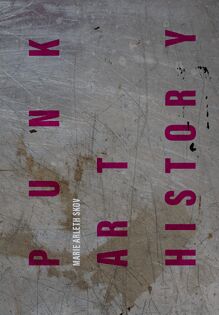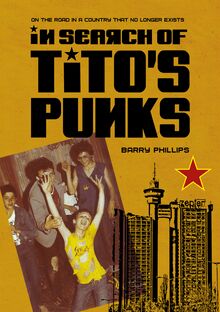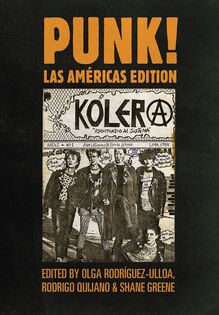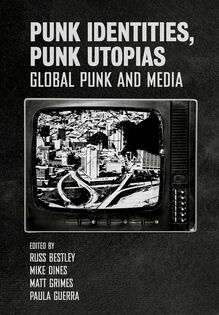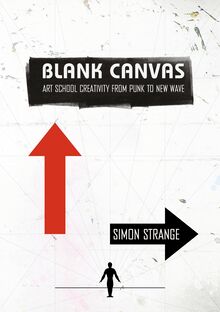-
 Univers
Univers
-
 Ebooks
Ebooks
-
 Livres audio
Livres audio
-
 Presse
Presse
-
 Podcasts
Podcasts
-
 BD
BD
-
 Documents
Documents
-
- Cours
- Révisions
- Ressources pédagogiques
- Sciences de l’éducation
- Manuels scolaires
- Langues
- Travaux de classe
- Annales de BEP
- Etudes supérieures
- Maternelle et primaire
- Fiches de lecture
- Orientation scolaire
- Méthodologie
- Corrigés de devoir
- Annales d’examens et concours
- Annales du bac
- Annales du brevet
- Rapports de stage
La lecture à portée de main
Vous pourrez modifier la taille du texte de cet ouvrage
Découvre YouScribe en t'inscrivant gratuitement
Je m'inscrisDécouvre YouScribe en t'inscrivant gratuitement
Je m'inscrisEn savoir plus
Vous pourrez modifier la taille du texte de cet ouvrage
En savoir plus

Description
The punk movement of the 1970s to early 1980s is examined as an art movement through archive research, interviews, and art historical analysis. It is about pop, pain, poetry, presence, and about a ‘no future’ generation refusing to be the next artworld avant-garde, instead choosing to be the ‘rear-guard’.
Skov draws on personal interviews with punk art protagonists from London, New York, Amsterdam, Copenhagen, and Berlin, among others the members Die Tödliche Doris (The Deadly Doris), members of Værkstedet Værst (The Workshop Called Worst), Nina Sten-Knudsen, Marc Miller, Diana Ozon, Hugo Kaagman, as well as email correspondence with Jon Savage, Anna Banana, and Genesis Breyer P-Orridge.
A large portion of the discussed materials stem from the protagonists' private archives, while some very public—scandalous and spectacular—events are discussed, too, such as the Prostitution exhibition at the ICA in London in 1976 and Die Große Untergangsshow (The Grand Downfall Show) in West-Berlin in 1981. The examined materials cover almost all media: paintings, drawings, bricolages, collages, booklets, posters, zines, installations, sculptures, Super 8 films, documentation of performances and happenings, body art, street art.
What emerges is how crucial the concept of history was in punk at that point in time. The punk movement's rejection of the tale of progress and prosperity, as it was being propagated on both sides of the iron curtain, evidently manifested itself in punk visual art too. Central to the book is the thesis that punks placed themselves as the rear-guards, not the avant-gardes, a statement which was in made by Danish punks in 1981, when they called themselves “bagtropperne". Behind the rear-guard watchword was the rejection of the inherent notion of progress that the avant-garde name brings with it; how could a "no future" movement want to lead the way?
Although aimed at students and scholars of art, design, music and performance history, the subject as well as the author’s accessible, occasionally playful style will no doubt draw readers with an interest in punk, music, and urban histories.
Acknowledgements
1 Prelude
1.1 What are we looking at? A punk art movement?
1.2 Negations, conflicts, and swindles: The elusiveness of punk
1.3 Case in point: The first Punk Art exhibition, 1978
1.4 Forty-five years of trying to capture the art in punk
2 Art Origins in the Story of Punk
2.1 The short version: From proto to post
2.2 Art school vs. hard school
2.3 Punk precursors: 1919, 1966, 1968
2.4 DIY: The DNA of punk
3 Pop Multiples, Camp Affirmations
3.1 Andy Warhol: "Hero of the Punks"
3.2 Hedonism as attack
3.3 Trash and travesty
4 The Weapons of the Underdog
4.1 Punk propaganda
4.2 Punk poetry
4.3 Crime as art, scandal as art
5 Art with No Future?
5.1 Originality and appropriation
5.2 Modernity in extremis
5.3 Avant-garde vs. rear-guard
6 Children Run Riot: The Art of the Infantile
6.1 Dead end kids
6.2 The Life of Sid Vicious: The sad, dead boy
6.3 "Infancy conforms to nobody"
7 Work vs. Play
7.1 Punk's homo ludens
7.2 Ingenious dilletantes
7.3 The Baby Wagner Lullaby, or: Brilliance blackout
8 SEX
8.1 Queer punks and dykes in high heels
8.2 Defiant prostitutes, porn artists & well-dressed whores
8.3 Sadism and submission
8.4 Punk feminism: Vamp up!
9 Pain and Presence
9.1 Performances and punches
9.2 "It hurts and looks cool!": Fetish fashion
9.3 Real romance?
10 Dystopian with a Twist
10.1 It's the end of the world
10.2 The Grand Downfall Show
10.3 Broken heroes, aces of failure
11 The Laws of the Lawless
List of Interviews and Archives
Notes
Bibliography
Index
Sujets
Informations
| Publié par | Intellect Books |
| Date de parution | 22 mars 2023 |
| Nombre de lectures | 0 |
| EAN13 | 9781789387025 |
| Langue | English |
| Poids de l'ouvrage | 12 Mo |
Informations légales : prix de location à la page 0,1750€. Cette information est donnée uniquement à titre indicatif conformément à la législation en vigueur.
Extrait
Global Punk
Series editors: Russ Bestley and Mike Dines
Produced in collaboration with the Punk Scholars Network, the Global Punk book series focuses on the development of contemporary global punk, reflecting its origins, aesthetics, identity, legacy, membership, and circulation. Critical approaches draw upon the interdisciplinary areas of (amongst others) cultural studies, art and design, sociology, musicology, and social sciences in order to develop a broad and inclusive picture of punk and punk-inspired subcultural developments around the globe. The series adopts an essentially analytical perspective, raising questions over the dissemination of punk scenes and subcultures and their form, structure, and contemporary cultural significance in the daily lives of an increasing number of people around the world. To propose a manuscript, or for more information about the series, please contact the series co-editors Russ Bestley and Mike Dines (contact details available at www.intellectbooks.com ).
The Punk Reader: Research Transmissions from the Local and the Global
Edited by Russ Bestley, Mike Dines, Alastair Gordon and Paula Guerra
Trans-Global Punk Scenes: The Punk Reader Vol. 2
Edited by Russ Bestley, Mike Dines, Alastair Gordon and Paula Guerra
Punk Identities, Punk Utopias: Global Punk and Media
Edited by Russ Bestley, Mike Dines, Matt Grimes and Paula Guerra
PUNK! Las Am ricas Edition
Edited by Olga Rodr guez-Ulloa, Rodrigo Quijano and Shane Greene
Blank Canvas: Art School Creativity From Punk to New Wave
Simon Strange
Punk Pedagogies in Practice: Disruptions and Connections
Edited by Francis Stewart and Laura Way
Punk Art History: Artworks From the European No Future Generation
Marie Arleth Skov
In Search of Tito s Punks: On the Road in a Country that No Longer Exists
Barry Phillips
First published in the UK in 2023 by Intellect, The Mill, Parnall Road, Fishponds, Bristol, BS16 3JG, UK
First published in the USA in 2023 by Intellect, The University of Chicago Press, 1427 E. 60th Street, Chicago, IL 60637, USA
Copyright 2023 Anna Dako
Produced in collaboration with the Punk Scholars Network
All rights reserved. No part of this publication may be reproduced, stored in a retrieval system, or transmitted, in any form or by any means, electronic, mechanical, photocopying, recording, or otherwise, without written permission.
A catalogue record for this book is available from the British Library.
Copy editor: MPS Limited
Cover designer: Russ Bestley
Indexing: Marie Arleth Skov
Production manager: Sophia Munyengeterwa
Typesetter: Russ Bestley
Part of the Global Punk series
ISSN 2632-8305 | ONLINE ISSN 2632-8313
Hardback ISBN 978-1-78938-747-6
Paperback ISBN 978-1-78938-700-1
ePDF ISBN 978-1-78938-701-8
ePUB ISBN 978-1-78938-702-5
Printed and bound by Gomer
To find out about all our publications, please visit www.intellectbooks.com .
There you can subscribe to our e-newsletter, browse or download our current catalogue and buy any titles that are in print.
This is a peer-reviewed publication.
Opening image: V RST (WORST), Im Eimer (Done for), 1985, from Das Zeug ( The Stuff ), 1986. Courtesy of Christian Lemmerz and Michael Kvium.
CONTENTS
ACKNOWLEDGMENTS
1 PRELUDE
1.1 What are we looking at? A punk art movement?
1.2 Negations, conflicts, and swindles: The elusiveness of punk
1.3 Case in point: The first Punk Art exhibition, 1978
1.4 Forty-five years of trying to capture the art in punk
2 ART ORIGINS IN THE STORY OF PUNK
2.1 The short version: From proto to post
2.2 Art school vs. hard school
2.3 Punk precursors: 1919, 1966, and 1968
2.4 DIY: The DNA of punk
3 POP MULTIPLES, CAMP AFFIRMATIONS
3.1 Andy Warhol: Hero of the Punks
3.2 Hedonism as attack
3.3 Trash and travesty
4 THE WEAPONS OF THE UNDERDOG
4.1 Punk propaganda
4.2 Punk poetry
4.3 Crime as art, scandal as art
5 ART WITH NO FUTURE?
5.1 Originality and appropriation
5.2 Modernity in extremis
5.3 Avant-garde vs. rear-guard
6 CHILDREN RUN RIOT: THE ART OF THE INFANTILE
6.1 Dead end kids
6.2 The Life of Sid Vicious: The sad, dead boy
6.3 Infancy conforms to nobody
7 WORK VS. PLAY
7.1 Punk s homo ludens
7.2 Ingenious Dilettantes
7.3 The Baby Wagner Lullaby, or Brilliance blackout
8 SEX
8.1 Queer punks and dykes in high heels
8.2 Defiant prostitutes, porn artists and well-dressed whores
8.3 Sadism and submission
8.4 Punk feminism: Vamp up!
9 PAIN AND PRESENCE
9.1 Performances and punches
9.2 It hurts and looks cool! : Fetish fashion
9.3 Real romance?
10 DYSTOPIAN WITH A TWIST
10.1 It s the end of the world
10.2 The Grand Downfall Show
10.3 Broken heroes, aces of failure
11 THE LAWS OF THE LAWLESS
LIST OF INTERVIEWS AND ARCHIVES
BIBLIOGRAPHY
INDEX
ACKNOWLEDGMENTS
The print of this book was supported by the New Carlsberg Foundation.
The PhD research on which this book builds was funded by a Mads vlisen PhD Scholarship within Art History from the Novo Nordisk Foundation.
Thank you to all of the artists who talked to me, showed me their archives, and to the artists, archives, and estates who gave me permission to print their artworks in this book: Anna Banana, Tabea Blumenschein/Townes Archive (Shoko Kawaida and Fetisch Terranova), GENESIS BREYER P-ORRIDGE, the estate of BREYER P-ORRIDGE and Benjamin Tischler, Neke Carson, Luciano Castelli, Cosey Fanni Tutti, Anno Dittmer, Estate of Leo Dohmen, Elmer, Gilbert George, Jutta Henglein-Bildau, Allen Jones, Estate Birgit J rgenssen, Hugo Kaagman, Per Katchetowa, Estate of Martin Kippenberger, K the Kruse, Michael Kvium, Christian Lemmerz, Marc Miller, Wolfgang M ller, Lars N rg rd, Knud Odde, Tom Otterness, Diana Ozon, Jamie Reid, Steen M ller Rasmussen, Ilse Ruppert, Jon Savage, Pennie Smith, Nina Sten-Knudsen, Ian Townson Archive, David Wise, and Xavier from Timeless Editions.
Thank you to the supervisors of my co-tutelle PhD thesis, Martin Schieder (Universit t Leipzig) and Mikkel Bolt Rasmussen (K benhavns Universitet). Thank you to Russ Bestley, Mike Dines, and the Punk Scholars Network. Thanks to the team at Intellect Books, especially Sophia Munyengeterwa. Thank you to my family and my friends, Laura, Aneta, Rie, Henrik, Morten, Emil, and Jens.
Shorter segments of this book have previously been published here:
Skov, Marie Arleth. The Art of the Enfants Terribles: Infantilism and Dilettantism in Punk Art. RIHA Journal , 0201 (15 November 2018).
Skov, Marie Arleth. The 1979 American Punk Art Dispute: Visions of Punk Art between Sensationalism, Street Art and Social Practice. Punk Post-Punk 9, no. 3 (2020), 443-66.
Skov, Marie Arleth. Surrealism and Punk: The Case of COUM Transmissions. In Radical Dreams: Surrealism, Counterculture, Resistance , edited by Elliott King and Abigail Susik, 207-33. University Park: Penn State University Press, 2022.
Skov, Marie Arleth. The Copenhagen Punk Years: Art with No Future? In A Cultural History of the Avant-Garde in the Nordic Countries 1975-2000 , edited by Benedikt Hjartarson, Camilla Paldam, Laura Schultz, and Tania rum, 643-61, Leiden, Boston: Brill Rodopi, 2022.
1 Prelude
Sometimes, punk is art. And sometimes, art is punk. Punk as a movement was not only just as visual as it was musical but also highly concerned with art as a concept and, specifically, with art history. In this book, the punk movement of the late 1970s to early 1980s is examined as an art movement through archive research, interviews, and art historical analysis. It is about pop and pain, poetry and presence. It is also about artists refusing to become the next artworld ism. Instead, the protagonists of the punk movement adopted and appropriated elements of history, especially art history, and in the process rendered meaningless formalist concepts of originality. Central to the book is the analysis of how punk themes are transported through art: themes like hedonism and (anti-)heroization, trash and fame, splendor and brokenness. Often, these artworks touch on contrarieties, and paradoxically turn them around: the artificial is the authentic, the guilty is the innocent, failure is success, and destruction is creation.
The punk movement rejected the tale of endless advance, progress, and prosperity in post-war western society. This sentiment evidently manifested itself in punk visual art too: it was about decadence, decline, and death. This stance, however, made the way for some very vivid artworks. Punks placed themselves as the rear-guards, not the avantgardes, a statement which was actually made by Danish punks in 1981, when they called themselves bagtropperne. Behind the rear-guard watchword was the rejection of the inherent notion of progress that the avant-garde name brings with it; how could a no future generation want to lead the way? In art history-parallel to political and social history-the tale of progress was coming to an end, too, most prominently disseminated in Arthur C. Danto s essay The Death of Art (1984). Like a seismograph, the punk movement of the late 1970s and early 1980s made the art-to-end-all-art, somehow an echo of past times and the epitome of its own time, anachronistic and zeitgeisty at the same time. In this book, we will take a look at what that meant: the role of conscious retrogression and chosen infantilism, of a youth movement between Oliver Twist realism and Peter Pan escapism.
It is my intent to show it, not tell it: this means we will be going through many (many!) examples and stories. Through these examples and stories, together we will move in on the topic area punk art history, in the sense of: punk in relation to art and in relation to art history- punk times art times history. An explosive equation. The book has eleven chapters: the first two will set the scene, followed by eight chapters exploring the themes of Punk Art History in depth, and finally ending with one chapter to boil it all down. Each chapter
-
 Univers
Univers
-
 Ebooks
Ebooks
-
 Livres audio
Livres audio
-
 Presse
Presse
-
 Podcasts
Podcasts
-
 BD
BD
-
 Documents
Documents
-
Jeunesse
-
Littérature
-
Ressources professionnelles
-
Santé et bien-être
-
Savoirs
-
Education
-
Loisirs et hobbies
-
Art, musique et cinéma
-
Actualité et débat de société
-
Jeunesse
-
Littérature
-
Ressources professionnelles
-
Santé et bien-être
-
Savoirs
-
Education
-
Loisirs et hobbies
-
Art, musique et cinéma
-
Actualité et débat de société
-
Actualités
-
Lifestyle
-
Presse jeunesse
-
Presse professionnelle
-
Pratique
-
Presse sportive
-
Presse internationale
-
Culture & Médias
-
Action et Aventures
-
Science-fiction et Fantasy
-
Société
-
Jeunesse
-
Littérature
-
Ressources professionnelles
-
Santé et bien-être
-
Savoirs
-
Education
-
Loisirs et hobbies
-
Art, musique et cinéma
-
Actualité et débat de société
- Cours
- Révisions
- Ressources pédagogiques
- Sciences de l’éducation
- Manuels scolaires
- Langues
- Travaux de classe
- Annales de BEP
- Etudes supérieures
- Maternelle et primaire
- Fiches de lecture
- Orientation scolaire
- Méthodologie
- Corrigés de devoir
- Annales d’examens et concours
- Annales du bac
- Annales du brevet
- Rapports de stage
